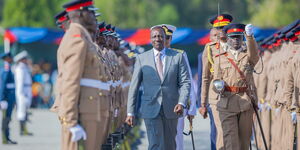In 2018, while introducing police reforms, Former President Uhuru Kenyatta underlined that the main basis for the changes was to encourage the police to serve the people.
One of the reforms was the introduction of the Persian Blue uniform which he stated would make the police “more visible”.
“It’s important for everybody and especially the police officers to know that the Kenyan people are funding these changes so that the police can serve the people better,” he noted.
The Persian Blue colour won by the police has continued to elicit debate, with many wondering why not red, or green and why many forces around the world wear blue uniforms.
Renowned criminologist, Sergio Herzog, notes that uniforms were introduced to aid police departments of the pre-World War I era pivot toward public service to their local communities.
Herzog, in a 2001 article in Policing and Society: An International Journal of Research and Policy, says that departments followed newly defined "professional" police goals, law enforcement became the exclusive and main specialization area of the police.
“The new image of the police was characterized by operational and technological sophistication, independence from external and political intervention, tight discipline according to a clear hierarchical scale of powers, obedience to orders and directives, internal control of police activities, and structural division into highly-specialized units,” Herzog says.
Police thus moved from aping soldiers or military attire to more likeable designs.
Uniforms were thus designed to convey certain messages, especially psychological effects that have a desired impact on the community.
Like in the US, some departments wear black after conducting different surveys that saw the colour appeal more than blue.
Origin of the Blue
In 1929, Robert Peel established the London Metropolitan Police, considered as the blueprint of modern law enforcement.
Reports indicate that Peel settled on blue to distinguish the police from the red colour worn by British soldiers.
He considered the blue a colour of authority yet one which inspired comfort, calmness, loyalty, and security in the society.
This colour was then adopted by the New York Police Department (NYPD) in 1845.
NYPD officers opposed the colour arguing that it was expensive and authoritarian, but the citizens differed, noting that it was easy to relate with and to spot police during emergencies.
Blue as a colour is also said to conceal stains, with police at times working over 8 hours.
It also aids in camouflaging, especially at night, as police track lawbreakers.












